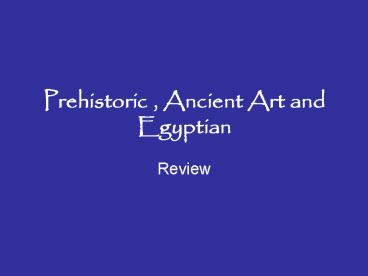Prehistoric , Ancient Art and Egyptian PowerPoint PPT Presentation
1 / 41
Title: Prehistoric , Ancient Art and Egyptian
1
Prehistoric , Ancient Art andEgyptian
- Review
2
Assignments 5/2
- Greek mosaic vase
- Greek composition
- Paper project -5
- Work on Career Tac Toe projects or get a handout
from me that will be due at the end of class. - 6 wks. Test and final exam will include
slides, the ability to list the principles and
elements, as knowledge of their definitions and
the ability to draw and recognize examples of
them. The steps of Art Criticism and the parts
of a credit line will be included.
3
Assignment 4/04-4/18
If you finish help a friend. Be sure you have
turned in the Greek Picture.
- 4/10 Draw and color or paint your scene on your
Greek Vase. - 4/11 Draw mosaic, use large open shapes to make
your picture, lightly indicate where your shading
should go. Begin cutting and gluing your paper
pieces, keeping them close together but not
touching. - 4/14 Work on mosaic, cutting, and piecing
carefully, leave a narrow white line around each
piece. Pieces should be close together. - Slide review
- 4/18 Complete and turn in mosaic today. You may
take it home an complete for turn in Mon. with no
credit off.
- Criteria
- Minimum of 7 decorative bands using traditional
Greek patterns. - One band must depict a scene from mythology, or
popular celebrity, music group etc. - The depiction must be done in the classical style
- One large band must be must contain a paper
mosaic that has shading, the pieces must not
overlap but must appear to have been grouted.
4
Art Slides
Prehistoric Ancient Classical
Paleolithic Cave Paintings of Lascaux Venus of Willendorf Neolithic Menhir/Standing stone Dolman Cromlech/ Stonehenge Mesopotamian Ziggurat Bas Relief Egyptian Khafres pyramid/Sphinx Pyramids at Giza, Egypt Nefertiti King Tuts mask Greek A roman copy of Myrons Discobolus, The Disc Thrower The Parthenon The Erechtheum/ Porch of madiens Venus de Milo The Nike of Samothrace (The winged Victory) Archaic, Classical, Helenistic Roman The Baker and his Wife Pantheon Barrel Vault Groin Vault Colosseum
5
Work Bank
- Parthenon
- Pantheon
- Classical
- Discobulos
- Ziggurat
- Post and lintel
- Tut
- Colosseum
- Barrel vault
- Groin vault
6
(No Transcript)
7
(No Transcript)
8
(No Transcript)
9
(No Transcript)
10
(No Transcript)
11
(No Transcript)
12
(No Transcript)
13
(No Transcript)
14
(No Transcript)
15
(No Transcript)
16
(No Transcript)
17
(No Transcript)
18
(No Transcript)
19
(No Transcript)
20
(No Transcript)
21
(No Transcript)
22
(No Transcript)
23
(No Transcript)
24
(No Transcript)
25
(No Transcript)
26
(No Transcript)
27
(No Transcript)
28
(No Transcript)
29
(No Transcript)
30
(No Transcript)
31
(No Transcript)
32
(No Transcript)
33
(No Transcript)
34
(No Transcript)
35
Answer any 4
- Where were the first recorded laws written up?
- By Whom?
- List 3 characteristics of Paleolithic times.
- List 3 characteristics of Neolithic times.
- Define ziggurats.
36
Match the item in the left column with the
correct description in the right column.
- Lintel
- Capital
- Shaft
- Stylobate
- Entablature
- Column
- Colonnade
- Pediment
- Cornice
- Raking cornice
- A sloping element that slants above the
horizontal cornice - A horizontal element above the frieze
- A cross-beam supported by columns
- The top element of a column
- The main weight-bearing portion of a column
- The top step of the 3-step platform
- The triangular section framed by the cornice and
the raking cornice - An upright post used to bear weight
- The upper portion of a temple, consisting of the
lintel, frieze, and cornice - The part of the structure formed by a line of
columns
37
Lesson Quiz 8-2
- True or False
- The kouros is noted for its sense of movement.
- Myron created the Discus Thrower in the early
Archaic Period. - Hellenistic sculptors created carefully carved
wooden figures. - The dying Gaul shows emotion in the Hellenistic
style. - Most of the surviving Greek sculptures are Roman
copies of original works.
balance stiff Procession of
Horsemen Proportion contrapposto
Phidias
- Write the word that belongs in the blank.
- The Hera of Samos displays a ___________________
pose. - ______________ created the original statue of
Athena at the Parthenon. - ____________is an example of relief sculpture
from the Parthenon. - Polyclytuss spear Bearer is shown in a pose
called _______________. - Greek sculptors perfected their skills in
creating works with __________,
_________________, and a sense of movement.
38
Study Sheet
- Define the following words, and/or answer the
questions. - pharaoh
- dynasty
- List the 3 major periods of Egyptian history.
- sarcophagus
- mastaba
- obelisk
- hieroglyphics
- Ra
- Ka
- Seradab
39
Study Sheet
- What were the primary functions of art in Ancient
Egyptian Society? - What characteristics distinguish Egyptian Art?
- Why did the Egyptian style of art remain the same
for thousands of years? - What two creatures are exhibited on the headdress
of the Pharaoh and what do they symbolize? - What is the Rosetta stone and why is it
important? - How are Neolithic and Egyptian art similar?
40
Rosetta stone
- Egyptian is one of the oldest languages in the
world. - It has 5,000 more gears of recorded history than
any other human language. - During the Middle ages it was replaced by Arabic
- It is a dead language.
- There are 4 forms of writing Egyptians used
- Hieroglyphics, Hieratic, Demotic, and Coptic.
- The Rosetta Stone was a fundamental part of
deciphering hieroglyphics today - There were three languages represented on top,
Egyptian Hieroglyphic, in the middle, Demotic,
and on the bottom, Greek
41
Word bank
- Venus of Willendorf
- Menhir
- Ziggurat
- Cave painting at Lascaux France
- Dolman
- Stele of Hammurabi

